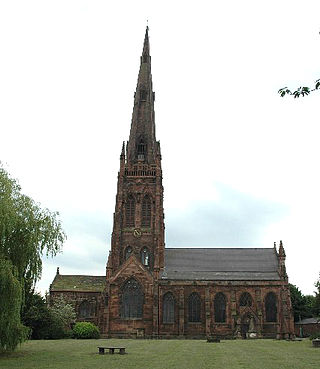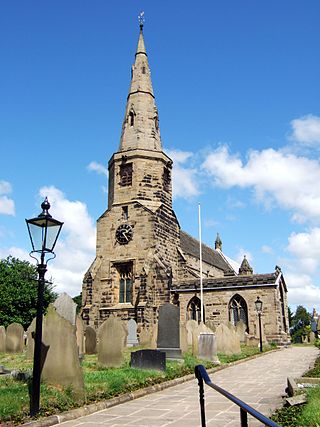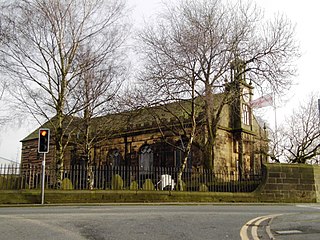
St Francis Xavier's Church is a Roman Catholic church in Salisbury Street, Everton, Liverpool, Merseyside, England. The church is recorded in the National Heritage List for England as a designated Grade II* listed building. It is an active parish church in the Archdiocese of Liverpool and the Pastoral Area of Liverpool North.

Albert Square is a public square in the centre of Manchester, England. It is dominated by its largest building, the Grade I listed Manchester Town Hall, a Victorian Gothic building by Alfred Waterhouse. Other smaller buildings from the same period surround it, many of which are listed.

St John's Gardens is an open space in Liverpool, England, to the west of St George's Hall. The gardens are part of the William Brown Street conservation area, and comprise one of the two open spaces within Liverpool's World Heritage Site. It has been a Green Flag site since 2003. The gardens contain ornamental flower beds, and memorials to notable people of the city.

Woolton Hall is a former country house located in Woolton, a suburb of Liverpool, England. Built in 1704 and extensively renovated in 1772 by the influential architect Robert Adam, the building is praised as the finest example of Adam's work in the North of England. Throughout its first 200 years, the building was the residence of a number of notable figures, including the Earl of Sefton and Liverpool shipowner Frederick Richards Leyland.

Allerton Hall is a Grade II* listed former country house in Clarke's Gardens, Allerton, Lancashire. It was built in 1736 for the Hardman family. It presently operates as a Public House.

The Church of Saint Andrew is a former Presbyterian church building in Rodney Street, Liverpool, Merseyside, England. It was part of the Church of Scotland. The church is recorded in the National Heritage List for England as a designated Grade II* listed building, and before redevelopment was on its Heritage at Risk Register.

Birkenhead Priory is in Priory Street, Birkenhead, Merseyside, England. It is the oldest standing building on Merseyside. The site comprises the medieval remains of the priory itself, the priory chapter house, and the remains of St Marys church. All three are recorded in the National Heritage List for England, though at different grades.

Sir John Gladstone, 1st Baronet, was a Scottish merchant, slave owner, and Tory politician best known for being the father of British Prime Minister William Ewart Gladstone.

The Hardmans' House, at 59 Rodney Street, Liverpool, Merseyside, England, is a National Trust property and home of the "E. Chambré Hardman Studio, House & Photographic Collection". The property was acquired by the National Trust in 2003.

Nant Gwynant is a valley in northern Wales. The A498 road descends 600 feet (180 m) into the valley in about two miles (3 km) from Pen-y-Gwryd; it follows the Nant Cynnyd, the Afon Glaslyn and alongside Llyn Gwynant, then beside the Nant Gwynant river to Llyn Dinas and passing below Dinas Emrys to Beddgelert. The road continues through the Aberglaslyn Pass to Porthmadog.

St Elphin's Church is the parish church of the town of Warrington, Cheshire, England. The church is recorded in the National Heritage List for England as a designated Grade II* listed building. It is an active Anglican parish church in the diocese of Liverpool, the archdeaconry of Warrington and the deanery of Warrington.

Burton Manor is a former manor house in the village of Burton, Cheshire, England. It is recorded in the National Heritage List for England as a designated Grade II listed building. At one time an adult education college, this is now closed, but the walled garden is open to the public and is administered by the Friends of Burton Manor Gardens.

Robertson Gladstone, was an English merchant and politician. He was the second son, and third child of Sir John Gladstone and the brother of William Ewart Gladstone who was Prime Minister of the United Kingdom four times. Robertson was a successful merchant, businessman, property developer and local politician. One of the youngest men elected Mayor of Liverpool, he was religious but increasingly tolerant of nonconformity, emphasised by a move towards semi-socialist politics.

The architecture of Liverpool is rooted in the city's development into a major port of the British Empire. It encompasses a variety of architectural styles of the past 300 years, while next to nothing remains of its medieval structures which would have dated back as far as the 13th century. Erected 1716–18, Bluecoat Chambers is supposed to be the oldest surviving building in central Liverpool.

Edward Fitzmaurice Chambré Hardman was an Anglo-Irish photographer, later based for most of his career in Liverpool. He was a landscape photographer by vocation, although his business was largely dependent on portraiture.

St Cuthbert's Church is an Anglican church in Halsall, a village in Lancashire, England. It is an active parish church in the Diocese of Liverpool and the archdeaconry of Warrington. The oldest parts of the church date from the 14th century and there have been several alterations and additions. It is recorded in the National Heritage List for England as a designated Grade I listed building.
Culshaw and Sumners was a firm of English architects and surveyors who practised in Liverpool in the 19th and early 20th centuries. The work of the practice reflected the growing economic prosperity of the city during this period. Much of its work was routine and mundane, but it did produce some notable buildings, including office blocks, warehouses, domestic properties, workhouses, churches, and a hospital. The firm was established by 1839 by William Culshaw, who was joined by Henry Sumners in 1861. Following Culshaw's death in 1874, the practice was continued until 1916 by his son, Alfred.
Ripley School Chapel is part of what is now the Ripley St Thomas Church of England Academy, located in Ashton Road, Lancaster, Lancashire, England. It is considered to be of architectural importance and is recorded in the National Heritage List for England as a designated Grade II* listed building.

St Aidan's Church is in Main Street, Billinge, St Helens, Merseyside, England. It is an active Anglican parish church in the diocese of Liverpool. It was built in 1716–18 to replace a chapel of ease on the site, and was remodelled and extended in 1907–08. The church is recorded in the National Heritage List for England as a designated Grade II* listed building.



















